Journal Description
Adolescents
Adolescents
is an international, peer-reviewed, open access journal on adolescent development and health sciences published quarterly online by MDPI.
- Open Access— free for readers, with article processing charges (APC) paid by authors or their institutions.
- High Visibility: indexed within Scopus and other databases.
- Rapid Publication: manuscripts are peer-reviewed and a first decision is provided to authors approximately 37.2 days after submission; acceptance to publication is undertaken in 4.6 days (median values for papers published in this journal in the second half of 2023).
- Recognition of Reviewers: APC discount vouchers, optional signed peer review, and reviewer names published annually in the journal.
Latest Articles
Associations between Household Food Insecurity and Depressive Symptomology among Adolescent Girls and Young Women during the COVID-19 Pandemic in South Africa
Adolescents 2024, 4(1), 185-199; https://doi.org/10.3390/adolescents4010013 - 21 Mar 2024
Abstract
Evidence suggests an association between food insecurity and depressive symptomatology; however, little is known about the association between adolescent girls and young women (AGYW) in the context of COVID-19. This study aimed to investigate the relationship between household food insecurity (HFI) and depressive
[...] Read more.
Evidence suggests an association between food insecurity and depressive symptomatology; however, little is known about the association between adolescent girls and young women (AGYW) in the context of COVID-19. This study aimed to investigate the relationship between household food insecurity (HFI) and depressive symptomology among AGYW in South Africa during the COVID-19 pandemic. Secondary data analysis was conducted using cross-sectional data collected from the HERStory2 study conducted during the COVID-19 pandemic. The data were collected from 515 AGYW (aged 15–24 years) recruited from six South African districts using a demographic detail and socio-economic questionnaire as well as the Center for Epidemiological Studies Depression (CESD-10) Scale. Data were fitted using a multi-variable robust Poisson regression model and controlled for sociodemographic and health factors. The results suggest that the majority of the sample of AGYW were 20 years old, with 74% exposed to HFI and 30.29% experiencing depressive symptomology. AGYW exposed to HFI were 1.80 times at risk of depressive symptomology compared to those from food-secure households [adjusted risk ratio (aRR): 1.80; 95% CI: 1.35–2.42, p < 0.0001)]. Future pandemic-preparedness strategies should incorporate screening for HFI as a means to identify AGYW who may require psychosocial support.
Full article
(This article belongs to the Section Adolescent Health and Mental Health)
Open AccessArticle
Development and Preliminary Validation of the Sexual Minority Identity Emotion Scale
by
Jacob Goffnett, Samantha Robinson, Anna Hamaker, Mohammod Mahmudur Rahman, Sheree M. Schrager and Jeremy T. Goldbach
Adolescents 2024, 4(1), 171-184; https://doi.org/10.3390/adolescents4010012 - 15 Mar 2024
Abstract
Emotions influence health behaviors and outcomes, yet little research has examined the emotion–health relationship among sexual minorities. The few studies in this area have used general measures of feelings without regard for identity, despite the literature positing emotions as culturally and contextually specific.
[...] Read more.
Emotions influence health behaviors and outcomes, yet little research has examined the emotion–health relationship among sexual minorities. The few studies in this area have used general measures of feelings without regard for identity, despite the literature positing emotions as culturally and contextually specific. This critical limitation obscures inferences made in studies that have found emotions to predict mental health outcomes for sexual minorities. This study begins to address this gap by developing and examining the preliminary validation of the Sexual Minority Identity Emotion Scale, a measure of shame and pride specific to the identity experiences of sexual minority adolescents. The initial pool of items emerged from a qualitative study and was refined through a multistep review. The measurement’s factor structure and criterion validity were examined using a nationwide sample of 273 sexual minority adolescents from the United States. The scale has four factors with strong internal reliability, adequate criterion validity, and utility in health research.
Full article
(This article belongs to the Section Adolescent Health and Mental Health)
Open AccessArticle
Tailoring Sexual Health Research Practices to Meet the Needs of Adolescent Girls in Low- and Middle-Income Countries: Findings from Mexico
by
Argentina E. Servin, Ruth Macklin, Sara Wilkerson, Teresita Rocha-Jiménez, Gudelia M. Rangel, Sophie E. O’Bryan and Celia B. Fisher
Adolescents 2024, 4(1), 158-170; https://doi.org/10.3390/adolescents4010011 - 07 Mar 2024
Abstract
Sexual and reproductive health (SRH) research is essential for the development of population-tailored evidence-based policies and programs that support sexual health among adolescent girls. However, ethical challenges create barriers to girls’ participation in low- and middle-income countries (LMICs). From February to September 2019,
[...] Read more.
Sexual and reproductive health (SRH) research is essential for the development of population-tailored evidence-based policies and programs that support sexual health among adolescent girls. However, ethical challenges create barriers to girls’ participation in low- and middle-income countries (LMICs). From February to September 2019, girls aged 16–20 (n = 30) who participated in the Jovenes Sanos study in Tijuana, Baja California (ClinicalTrials: NCT03660514) responded to in-depth interviews (IDs) on the perceived risks and benefits of participating in studies which address gender-based violence, unintended pregnancy, and STIs. Emergent themes indicated the need to ensure that consent and incentive procedures are tailored to the developmental level of participants, while highlighting the importance of researcher–participant relationships, and demonstrating how research can serve as an opportunity to empower girls to express their sexual health medical needs. Understanding adolescent girls’ voices is a critical step in ensuring that consent to participate SRH research is tailored to the developmental needs of participants, is culturally competent, and has a participant-centered approach.
Full article
(This article belongs to the Section Adolescent Health and Mental Health)
Open AccessArticle
Prevalence of and Influential Factors for Waterpipe Smoking among School-Attending Adolescents in Bissau, Guinea-Bissau
by
Jónína Einarsdóttir, Aladje Baldé, Zeca Jandi, Hamadou Boiro and Geir Gunnlaugsson
Adolescents 2024, 4(1), 138-157; https://doi.org/10.3390/adolescents4010010 - 06 Mar 2024
Abstract
The marketing of sweetened and flavoured tobacco in the early 1990s resulted in an upsurge in waterpipe smoking (WPS), mainly among young people and women. Here, we estimate prevalence rates among school-attending adolescents aged 14–19 (girls 52%) for a lifetime experience of WPS
[...] Read more.
The marketing of sweetened and flavoured tobacco in the early 1990s resulted in an upsurge in waterpipe smoking (WPS), mainly among young people and women. Here, we estimate prevalence rates among school-attending adolescents aged 14–19 (girls 52%) for a lifetime experience of WPS and within the last 30 days (WPS < 30 days) and identify influential factors for such smoking in Bissau, Guinea-Bissau. A random sample (N = 2039) was drawn from a class-based register created for 16 schools in Bissau; attending students in June 2017 were invited to respond to a locally adapted Planet Youth questionnaire. Descriptive statistics, odds ratio with 95% confidence interval, and multinomial logistic regression analysis were used to identify influential factors for WPS. The prevalence rates for a lifetime experience of WPS and within < 30 days were high, 17.7% and 15.0%, respectively, with no significant gender difference. For both groups, a multinomial logistic regression analysis identified attending higher grades in school, use of alcohol and being a victim of sexual violence as significant, influential factors. The overlapping of influential factors suggests preventive work against substance abuse should focus on less stigmatising behaviour, such as WPS and firmer implementation of the Framework Convention of Tobacco Control (FCTC).
Full article
(This article belongs to the Section Adolescent Health Behaviors)
►▼
Show Figures
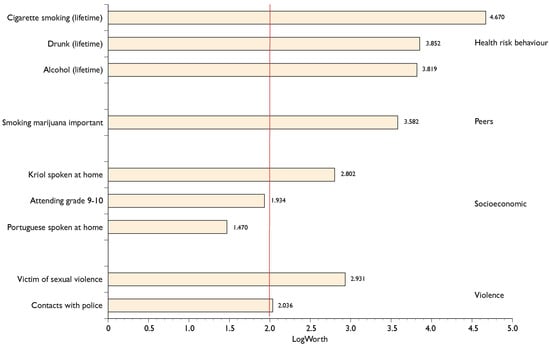
Figure 1
Open AccessArticle
Stress Appraisals and Coping across and within Academic, Parent, and Peer Stressors: The Roles of Adolescents’ Emotional Problems, Coping Flexibility, and Age
by
Melanie J. Zimmer-Gembeck and Ellen A. Skinner
Adolescents 2024, 4(1), 120-137; https://doi.org/10.3390/adolescents4010009 - 17 Feb 2024
Abstract
The aim of this study was to determine whether adolescents’ emotional problems, coping flexibility, age, and stress appraisals account for ways of coping, which include engagement and disengagement coping, with academic-, parent-, and peer-related stressful events. Stress appraisals were defined as perceived threats
[...] Read more.
The aim of this study was to determine whether adolescents’ emotional problems, coping flexibility, age, and stress appraisals account for ways of coping, which include engagement and disengagement coping, with academic-, parent-, and peer-related stressful events. Stress appraisals were defined as perceived threats to the psychological needs of relatedness, competence, and autonomy. Models were fit at a higher order level, indicated by adolescents’ appraisals and intended ways of coping with stress in three domains (i.e., academic, parent, and peer) and tested at the lower level within each domain. Adolescents (N = 410; age 10–15; Mage = 12.5; 50% girls) reported their emotional problems (combined depressive and anxiety symptoms) and coping flexibility six months prior to completing an analogue task. The task involved viewing six short film clips portraying stressful events (e.g., obtaining a worse than expected exam grade or arguing with a parent) and reporting three stress appraisals and eight ways of coping after each stressor. The ways of coping were analyzed as four composite scores reflecting engagement coping (active coping, self-reliance) or disengagement coping (withdrawal coping, helplessness). In structural equation models, adolescents who appraised more threat reported more withdrawal coping and helplessness but also more active coping and self-reliance. Adolescents with more emotional problems appraised more threat and anticipated using less constructive ways of coping, whereas adolescents higher in coping flexibility intended to use more constructive ways of coping, with these associations sufficiently modeled at the general (across stress domains) level. Improvement in the model fit was found when appraised threat–coping associations were modeled at the lower (specific stressor domain) level, suggesting differences by stressor domain. Age was associated with more self-reliance and helplessness, with self-reliance being specific to parent stressors and helplessness specific to peer stressors.
Full article
(This article belongs to the Section Adolescent Health and Mental Health)
►▼
Show Figures
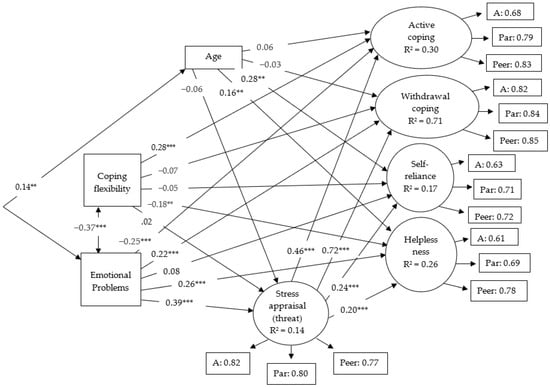
Figure 1
Open AccessArticle
Problematic Smartphone Use and Communication in Families with Adolescents
by
Marina Merkaš, Matea Bodrožić Selak and Ana Žulec Ivanković
Adolescents 2024, 4(1), 107-119; https://doi.org/10.3390/adolescents4010008 - 07 Feb 2024
Abstract
►▼
Show Figures
Research examining the relations among adolescent’s problematic smartphone use, parent–adolescent conflicts about smartphone use, family communication, and adolescent communication skills is scarce. Thus, the study empirically examined a model of the direct and indirect effects of adolescents’ problematic smartphone use on adolescent communication
[...] Read more.
Research examining the relations among adolescent’s problematic smartphone use, parent–adolescent conflicts about smartphone use, family communication, and adolescent communication skills is scarce. Thus, the study empirically examined a model of the direct and indirect effects of adolescents’ problematic smartphone use on adolescent communication skills via family communication and parent–adolescent conflicts about smartphone use. The data used for the creation of this paper came from a sample of 284 adolescents (59.4% girls), aged 10 to 15, who participated in a four-wave longitudinal study (2021–2023) examining the effects of smartphone use on well-being and development. Adolescents rated their problematic smartphone use (wave 1), conflicts with parents about their smartphone use (wave 2), family communication (wave 3), and communication skills (wave 4). There was no support for the direct effect of problematic smartphone use on communication skills. Our path analysis showed a significant indirect effect of problematic smartphone use on communication skills via family communication. Our analysis also showed a significant direct effect of problematic smartphone use on conflicts between parents and adolescents about the time spent using smartphones and balancing activities with smartphone use. The findings of this study imply that excessive and extensive smartphone use may pose a risk factor for frequent parent–adolescent conflicts, poor family communication, and poor adolescent communication skills.
Full article
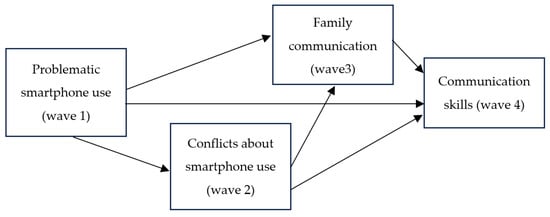
Figure 1
Open AccessArticle
Transforming Service into Civic Purpose: A Qualitative Study of Adolescent Civic Engagement and Purpose Development
by
Brenna Lincoln, Kira N. Patel, Molly Binder, Terese J. Lund and Belle Liang
Adolescents 2024, 4(1), 90-106; https://doi.org/10.3390/adolescents4010007 - 02 Feb 2024
Abstract
As tomorrow’s leaders, adolescents are navigating coming-of-age tasks in the context of both the fast-growing promises of technology and the burdens of overwhelming global challenges. The Climate Leaders Fellowship (CLF) is an extracurricular program that supports adolescents interested in environmental sustainability. Program participants
[...] Read more.
As tomorrow’s leaders, adolescents are navigating coming-of-age tasks in the context of both the fast-growing promises of technology and the burdens of overwhelming global challenges. The Climate Leaders Fellowship (CLF) is an extracurricular program that supports adolescents interested in environmental sustainability. Program participants are connected with like-minded peers and mentors across the globe who help them develop and implement community-based volunteer projects (CLF, 2022). This study focuses on whether and how participation in CLF shaped adolescents’ development. A directed content analysis approach was utilized to conduct and analyze semi-structured interviews with adolescent CLF participants (n = 9, 89% female). Results indicate that engagement in the program is associated with civic purpose development. Specifically, participants reported experiencing civic reflection, motivation, and action through their CLF involvement. Findings offer supporting evidence that the development of civic purpose may be associated with burgeoning critical consciousness. Recommendations for future programming, study limitations, and implications are discussed.
Full article
(This article belongs to the Section Emerging and Contemporary Issue in Adolescence)
►▼
Show Figures
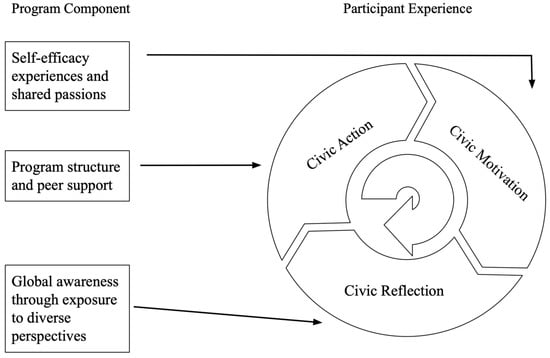
Figure 1
Open AccessArticle
The Relationship between Family Characteristics and Adolescent Perception of the Quality of Family Communication
by
Martina Feric
Adolescents 2024, 4(1), 75-89; https://doi.org/10.3390/adolescents4010006 - 01 Feb 2024
Abstract
Many studies consider family communication to be one of the most important protective factors for the positive development of children and adolescents in the family environment. This paper aims to clarify whether some characteristics of the family environment influence the quality of family
[...] Read more.
Many studies consider family communication to be one of the most important protective factors for the positive development of children and adolescents in the family environment. This paper aims to clarify whether some characteristics of the family environment influence the quality of family communication in order to provide guidelines for the planning of prevention strategies that effectively improve the quality of family communication and, thus, the positive development of adolescents. Specifically, the aim is to investigate whether there are gender- and age-related differences in the assessment of the quality of family communication and whether there are differences in the assessment of the quality of family communication depending on some family characteristics. High school students from five large Croatian cities (Zagreb, Osijek, Split, Pula, and Varazdin) took part in this study. The quota sample is stratified by three Croatian high school programs, as well as by individual program orientations within each school. The results show that there are differences in assessment of the quality of family communication in relation to gender, age, living with both or one parent, and the educational and working status of the parents. The data suggest that, in addition to the timely implementation of evidence-based parenting and/or family-based prevention interventions, there is a need to invest in high-quality social policies that could lead to a better quality of family life by increasing the chances of higher educational attainment for (future) parents as well as adequate employment opportunities.
Full article
Open AccessArticle
School Scoliosis Screening: The Influence of Dominant Limbs and Gender
by
Eleni Theodorou, Marios Hadjicharalambous and Marios Tryfonidis
Adolescents 2024, 4(1), 62-74; https://doi.org/10.3390/adolescents4010005 - 24 Jan 2024
Abstract
This study aimed to examine whether (a) there is an association of the dominant hand (DH) and leg (DL) with the side of the primary angle of trunk rotation (ATR A) and (b) there are any differences between boys and girls in the
[...] Read more.
This study aimed to examine whether (a) there is an association of the dominant hand (DH) and leg (DL) with the side of the primary angle of trunk rotation (ATR A) and (b) there are any differences between boys and girls in the degree of the angle of trunk rotation (ATR) and the dominant hand and leg. One thousand sixty-five (age: 14 ± 3 years; height: 162 ± 13 cm; weight: 56 ± 18.7 kg; BMI: 21.18 ± 5.07) secondary school children participated in this study. Of the participants, 52.5% (n = 559) were male students (age: 14 ± 2 years; height: 166 ± 16 cm; weight: 58.7 ± 22.6 kg; BMI: 21.41 ± 5.61), and 47.5% (n = 506) were female students (age: 14 ± 3 years; height: 159.5 ± 8.5 cm; weight: 53.9 ± 14.8 kg; BMI: 21.03 ± 4.38). The ATR was measured with a scoliometer. Boys were taller and heavier (p = 0.001) and had more left DLs (p = 0.039) than girls. Girls were biologically more mature (p = 0.002), also having higher measurements for the ATR A (p = 0.004) and secondary angle of trunk rotation (ATR B) (p = 0.023) degrees compared to boys. In the general sample, only in boys, there was a significant association between the DH (p = 0.012) and DL (p = 0.001) with the ATR A side. Also, within the scoliotic group, only in boys, there was a significant association between the DH (p = 0.048) and DL (p = 0.024) with the ATR A. In conclusion, girls had higher measurements for the ATR than boys, but cross laterality was found only in boys. The results suggest different progression patterns of ATR between genders during their growth. Future research should focus on examining other possible progression mechanisms.
Full article
(This article belongs to the Section Adolescent Health and Mental Health)
►▼
Show Figures

Figure 1
Open AccessArticle
“I Prefer Eating Less Than Eating Healthy”: Drivers of Food Choice in a Sample of Muslim Adolescents
by
Lucie Nield
Adolescents 2024, 4(1), 41-61; https://doi.org/10.3390/adolescents4010004 - 04 Jan 2024
Abstract
Adolescence is a time of significant change which is experienced differently across sociocultural contexts. Understanding drivers of food practice in adolescence is vital as these impact future health outcomes and can drive health inequality. This study investigates drivers of food choice in predominantly
[...] Read more.
Adolescence is a time of significant change which is experienced differently across sociocultural contexts. Understanding drivers of food practice in adolescence is vital as these impact future health outcomes and can drive health inequality. This study investigates drivers of food choice in predominantly British–Asian, Muslim adolescents living in a deprived urban area of England. It identifies dominant drivers of food choice and their impact on health and wellbeing, and explores how Muslim adolescents from a low socioeconomic, British–Asian group understand and action autonomy in their food practices. PhotoVoice, a focussed ethnographical methodology where participants reflect on lived experience, was used to address the study aim. Participants (n = 21) were secondary school pupils aged 14–15 years, recruited from a school situated in an area of deprivation. Four overarching themes were developed from the qualitative data framework analysis: (1) food preference and other determinants of food choice; (2) concept, understanding and importance of health; (3) developing autonomy, skills, and independence; and (4) role of community, friends, and family in food practices. The adolescents were developing autonomy in relation to their food practices, whilst navigating a complex web of factors which were, in part, determined by their social class location and demographics. Participants understood the constituents of healthy eating. However, there was a perceived “effort” of being healthy, including additional time for preparing healthier food and sacrificing taste preferences. Parents, friends, and schools highly influence food choices, with adolescents preferring a broad palate of takeaway and convenience foods and would prefer to eat less of these “unhealthy” options than eat healthily.
Full article
(This article belongs to the Section Adolescent Health Behaviors)
►▼
Show Figures

Figure 1
Open AccessArticle
Perspectives Matter: Insecure Residency Status Accounts for Aggressive Emotions in Adolescent Refugees
by
Lara L. Eder, Alexandra Martin, Gerhard Hapfelmeier and Marco Walg
Adolescents 2024, 4(1), 28-40; https://doi.org/10.3390/adolescents4010003 - 03 Jan 2024
Abstract
Unaccompanied refugees are a high-risk group for trauma-induced psychiatric disorders. Besides traumatic experiences pre- and during migration, post-migration stressors such as insecure residency status affect refugees’ mental health and foster aggressive emotions. High levels of psychological distress and psychopathology distort time perspectives. Consequently,
[...] Read more.
Unaccompanied refugees are a high-risk group for trauma-induced psychiatric disorders. Besides traumatic experiences pre- and during migration, post-migration stressors such as insecure residency status affect refugees’ mental health and foster aggressive emotions. High levels of psychological distress and psychopathology distort time perspectives. Consequently, an insecure residency status linked to distress may influence a refugee’s time perspective. This study investigated psychological distress, PTSD symptoms, aggressive emotions, and time perspectives in 33 unaccompanied adolescent refugees with and without secure residency status in Germany. Refugees with precarious residency status showed higher levels of overall distress and aggression than individuals with secure residency status. Both groups revealed a distorted time perspective profile, but individuals with a residence permit showed a stronger orientation toward the present hedonistic perspective than those without a permit. Higher aggressive emotions were related to insecure status, higher levels of psychological distress, more pronounced PTSD symptoms, and lower orientation to future time perspective. Distorted time perspectives among refugees may be caused by traumatic experiences and having been uprooted, independently of their residency status in the host country. A higher future orientation may buffer the association between distorted time perspectives and aggressive emotions in the highly stressed group of unaccompanied adolescent refugees.
Full article
(This article belongs to the Section Adolescent Health and Mental Health)
►▼
Show Figures
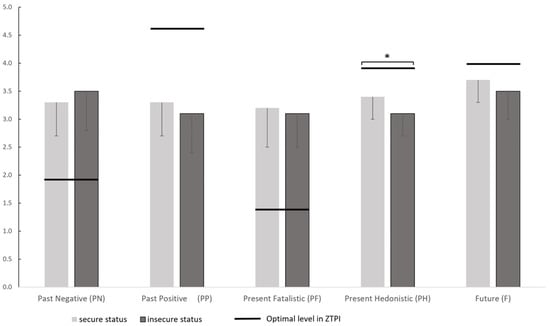
Figure 1
Open AccessArticle
Perceived Physical Competence, Self-Esteem, and Leadership among Girls: A Program Evaluation of GOALS (Girls Organizing and Learning Sport)
by
Bailey Csabai, Barbara A. Pollard and Sarah J. Woodruff
Adolescents 2024, 4(1), 14-27; https://doi.org/10.3390/adolescents4010002 - 03 Jan 2024
Abstract
This study evaluated a leadership-based physical activity program, Girls Organizing and Learning Sport (GOALS), by assessing changes in health behaviours, physical competence, self-esteem, and leadership. Of the 466 participants who enrolled in the program, 102 (22%) completed a pre-and post-program survey containing questions
[...] Read more.
This study evaluated a leadership-based physical activity program, Girls Organizing and Learning Sport (GOALS), by assessing changes in health behaviours, physical competence, self-esteem, and leadership. Of the 466 participants who enrolled in the program, 102 (22%) completed a pre-and post-program survey containing questions concerning demographics, physical activity, physical competence, self-esteem, and leadership. The GOALS program was held twice (fall 2022/winter 2023) and consisted of two-hour weekly sessions over four weeks at nine different locations. Paired-sample t-tests, Chi-squares, and one-way ANOVA tests were utilized to analyze differences before and after the GOALS program. Results revealed that more participants were involved in school sports, community sports, and regular physical activity post-program (all p’s < 0.05). A significant difference was also observed between pre-and post-test scores for physical competence and self-esteem (p’s < 0.05). However, the program did not elicit changes in health behaviours or total leadership scores (all p’s > 0.05). Moreover, significant results were observed between physical competence difference scores and those who care for their health by exercising (p = 0.025), leadership difference scores and those who take care of their health by exercising (p = 0.044), self-esteem difference scores by program location (p = 0.001), and physical competence difference scores by ethnicity (p = 0.003). Overall, further research into the design, administration, and targeted outcomes is recommended for future sessions.
Full article
(This article belongs to the Section Adolescent Health Behaviors)
►▼
Show Figures

Figure 1
Open AccessArticle
“Instead of Asking for Fare, You Ask Her to Pay with Sex”: Male Perspectives on the Factors Influencing Schoolgirls’ Participation in Age-Disparate Transactional Sex Relationships
by
Leso Munala, Asha Mohamed, Nene Okunna, Bethlehem Yewhalawork, Paul Kibati and Jesse Kihuha
Adolescents 2024, 4(1), 1-13; https://doi.org/10.3390/adolescents4010001 - 20 Dec 2023
Abstract
Age-disparate transactional sex relationships are often coerced and exploitative. The gender and economic disparities between affluent men and economically disadvantaged girls often perpetuate these relationships, resulting in their exploitation. This qualitative study assessed men’s understanding of factors influencing schoolgirls’ engagement in age-disparate transactional
[...] Read more.
Age-disparate transactional sex relationships are often coerced and exploitative. The gender and economic disparities between affluent men and economically disadvantaged girls often perpetuate these relationships, resulting in their exploitation. This qualitative study assessed men’s understanding of factors influencing schoolgirls’ engagement in age-disparate transactional sex relationships in two rural districts in Kenya. Four focus group sessions were conducted with men from two primary professions: motorcycle taxi operators (Boda Boda) and teachers from primary and secondary schools from two districts in Kitui South, Sub County, Kenya. Focus group data were analyzed using conventional content analysis. Several influential factors associated with schoolgirls’ engagement in these transactional relationships are discussed in three broad themes: access and coercion, parental influence, and peer-related factors. Study results indicate that schoolgirls in rural areas are more susceptible to predation by men willing to trade sexual favors with underage girls. These findings make it imperative to address the predation of adolescent girls by men involved in these transactional relationships by implementing comprehensive sex education programs that empower schoolgirls to recognize and resist coercion. Additionally, implementing measures involving community leaders, parents, and other stakeholders in a collective effort to combat the exploitation of underage girls is paramount. These measures should be accompanied by the stricter enforcement of laws and regulations to hold perpetrators accountable for their actions.
Full article
(This article belongs to the Section Emerging and Contemporary Issue in Adolescence)
Open AccessArticle
Youth–Therapist and Parent–Therapist Match and Mismatch on Internalizing and Externalizing Treatment Goals as Predictors of Treatment Engagement
by
May Yeh, Devynne Diaz, Argero Zerr, Alisandra Macias and Kristen McCabe
Adolescents 2023, 3(4), 678-692; https://doi.org/10.3390/adolescents3040048 - 13 Dec 2023
Abstract
Therapist–client cognitive match upon key constructs such as treatment goals is purported to be an important component of culturally competent care. For adolescent clients, treatment may involve both youths and their parents, suggesting the need to consider both youth–therapist and parent–therapist perspectives. This
[...] Read more.
Therapist–client cognitive match upon key constructs such as treatment goals is purported to be an important component of culturally competent care. For adolescent clients, treatment may involve both youths and their parents, suggesting the need to consider both youth–therapist and parent–therapist perspectives. This longitudinal study examined broadband youth–therapist and parent–therapist treatment goal matching and mismatching in relationship to treatment engagement in a culturally diverse sample of 245 outpatient mental health service-using youth. Although goal matching/mismatching did not uniformly predict treatment engagement as measured by a total score, youth–therapist internalizing goal matching predicted better youth engagement, and parent–therapist externalizing goal mismatch marginally predicted worse parent engagement. When selected post hoc analyses examined relationships to four individual engagement dimensions, youth–therapist internalizing goal matches positively predicted youth Client–therapist interaction, Communication/Openness, Client’s perceived usefulness of therapy, and Collaboration with treatment, while parent–therapist externalizing goal mismatch negatively predicted parent Collaboration with treatment. Findings support the importance of cognitive match on treatment goals as well as the consideration of both parent and youth perspectives, matched and mismatched goals, internalizing and externalizing goals, and examining individual dimensions in addition to total scores of engagement.
Full article
(This article belongs to the Section Adolescent Health and Mental Health)
Open AccessReview
Adolescents and Electronic Vapor Product Use: A Dangerous Unknown
by
Sarah Yale, Vanessa McFadden and Theresa Mikhailov
Adolescents 2023, 3(4), 667-677; https://doi.org/10.3390/adolescents3040047 - 03 Nov 2023
Abstract
Electronic vapor products (EVPs) are non-conventional tobacco products that use a battery to heat liquid, generating an aerosol to be inhaled by the user. Despite being initially proposed as a harm reduction tool for adults looking to quit conventional tobacco cigarettes, EVP usage
[...] Read more.
Electronic vapor products (EVPs) are non-conventional tobacco products that use a battery to heat liquid, generating an aerosol to be inhaled by the user. Despite being initially proposed as a harm reduction tool for adults looking to quit conventional tobacco cigarettes, EVP usage has grown significantly in the adolescent population over the past decade. Data from the 2021 Youth Risk Behavior Survey (YRBS) show that currently, in the United States, 36% of adolescents have ever used an EVP, 18% currently use an EVP, and 5% use EVPs daily. Initial studies have raised concerns about the health effects on multiple organ systems (e.g., respiratory, cardiovascular, and neurodevelopmental), and little information is known about the long-term effects, as well as the impacts specific to the still-developing adolescent body. EVP usage in the adolescent population is a public health crisis. The purpose of this narrative review is to address what is known thus far and to advise areas of focus for future research and advocacy.
Full article
Open AccessArticle
Adolescents Hospitalized for Psychiatric Illness: Caregiver Perspectives on Challenges
by
Alexia D’Angelo, Antonia Ofosu and Michèle Preyde
Adolescents 2023, 3(4), 651-666; https://doi.org/10.3390/adolescents3040046 - 31 Oct 2023
Abstract
Adolescents with psychiatric illness severe enough to be hospitalized experience many challenges that are also experienced by their caregivers and other family members. The purpose of this study was to explore the challenges experienced by these adolescents and their families from the perspective
[...] Read more.
Adolescents with psychiatric illness severe enough to be hospitalized experience many challenges that are also experienced by their caregivers and other family members. The purpose of this study was to explore the challenges experienced by these adolescents and their families from the perspective of the caregivers. A cross-sectional survey with open-ended questions and standardized measures was administered to caregivers while their children were in hospital. Caregivers (n = 24) reported significant challenges related to the psychological problems their adolescents were experiencing, and additional burdens that influenced the family context in which the adolescents were developing. Adolescents with psychiatric illness may be contributing to and developing in stressful family contexts. Implications include the need for interventions for caregivers alongside the psychiatric care provided for their children and specialized supports for their complex situation.
Full article
(This article belongs to the Section Adolescent Health and Mental Health)
Open AccessArticle
Factors Associated with the Prevalence and Treatment of Depression in Adolescent Males in the US during the Period of the COVID-19 Pandemic
by
Onur Baser, Yixuan Zeng, Sara Alsaleh and Isabel Baser
Adolescents 2023, 3(4), 640-650; https://doi.org/10.3390/adolescents3040045 - 25 Oct 2023
Abstract
Background: Much of the research on the effect of the COVID-19 pandemic on mental health has overlooked the experiences of adolescent boys. Objective: To examine the prevalence of depression, treatment trends, and associated risk factors among adolescent boys, controlling for the pandemic year.
[...] Read more.
Background: Much of the research on the effect of the COVID-19 pandemic on mental health has overlooked the experiences of adolescent boys. Objective: To examine the prevalence of depression, treatment trends, and associated risk factors among adolescent boys, controlling for the pandemic year. Methods: Data for boys aged 12 to 17 years (n = 4518) in the 2021 National Survey on Drug Use and Health were analyzed. Time trends and factors associated with depression were examined using a multiple regression analysis. Results: The prevalence of 12-month major depressive episodes (TMDEs) was 11.6% during the first year of the COVID-19 pandemic. Among the boys with TMDEs, 37.8% received treatment overall, and 19.0% received prescription medication. Higher rates of TMDEs were estimated in boys who were older (adjusted odds ratio (AOR): 1.66, p < 0.001), lived in single-mother households (AOR: 1.47, p < 0.001), did not have authoritative parents (AOR: 1.78, p < 0.001), and had negative school experiences (AOR: 2.45, p < 0.001). Although Black boys were less likely to report depression than white boys (AOR: 0.70, p < 0.05), nonwhite boys who had depression were significantly less likely to receive treatment. Boys living in a household without a mother were also less likely to receive treatment (AOR: 0.49, p < 0.05). Conclusions: This study reveals the unique developmental, social, and psychological factors that influence depression among adolescent boys. During the pandemic, more than one out of ten adolescent boys had a major depressive episode, and four of ten of them received treatment; half of these treatments were prescription medication. Recognizing these factors may allow for more targeted and effective interventions to improve mental health outcomes for this demographic.
Full article
(This article belongs to the Section Adolescent Health and Mental Health)
Open AccessArticle
Anthropometric and Physical Fitness Profile of Adolescent Inter-County Ladies’ Gaelic Football Players
by
Teresa Molohan, Stephen Behan and Áine MacNamara
Adolescents 2023, 3(4), 625-639; https://doi.org/10.3390/adolescents3040044 - 11 Oct 2023
Abstract
The aim of this study was to determine the anthropometric and physical fitness profiles of inter-county female Gaelic football players from under-14 to under-18 age levels. A total of 156 athletes (U14, n = 33; U16, n = 64; U18, n = 59)
[...] Read more.
The aim of this study was to determine the anthropometric and physical fitness profiles of inter-county female Gaelic football players from under-14 to under-18 age levels. A total of 156 athletes (U14, n = 33; U16, n = 64; U18, n = 59) participated in this study. Testing was conducted in a single session for each group and included anthropometric measures of standing and sitting height, weight, estimated age of peak height velocity (PHV), and maturity offset. Physical performance tests included squat jump (SJ), countermovement jump (CMJ) and drop jump (DJ), 0–5 m and 0–20 m sprint times, pro-agility test, medicine ball chest-pass throw, and YoYo intermittent recovery test level 1 (YoYoIR1). A one-way analysis of variance (ANOVA) was used to investigate differences between the age groups. Significant differences were identified between age groups for measures of height (p < 0.001, ES = 0.127), body mass (p.002, ES = 0.076), and estimated age of PHV (p < 0.001, ES = 0.612). No significant differences were found between age groups for any of the physical fitness tests except for the YoYoIR1, where a significant difference was found between the U14 and U18 age groups (p.029, η2p = 0.048). These findings may assist coaches to better understand female athletic development, provide insight on talent identification and development programmes, and provide reference data when working with this cohort so that realistic and attainable training goals can be achieved.
Full article
(This article belongs to the Section Adolescent Health and Mental Health)
►▼
Show Figures
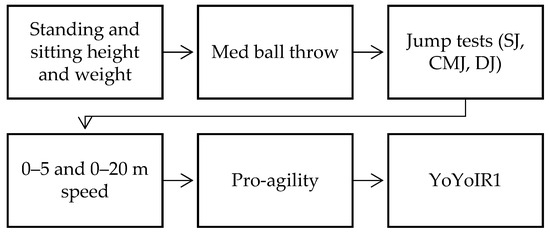
Figure 1
Open AccessArticle
Effect of Adolescent Health Policies on Health Outcomes in India
by
Sayooj Sahadevan, Maureen Dar Iang and Fekri Dureab
Adolescents 2023, 3(4), 613-624; https://doi.org/10.3390/adolescents3040043 - 07 Oct 2023
Abstract
Adolescence is a crucial phase marked by significant physical, psychological, emotional, and social changes. India has the world’s largest adolescent population. Understanding and addressing their health needs is vital for the nation’s social, political, and economic progress. The primary aim of this study
[...] Read more.
Adolescence is a crucial phase marked by significant physical, psychological, emotional, and social changes. India has the world’s largest adolescent population. Understanding and addressing their health needs is vital for the nation’s social, political, and economic progress. The primary aim of this study was to evaluate the main adolescent health policies and strategies implemented from 2006 to 2020 and analyze the outcomes for adolescent health in India. To achieve this objective, the research adopted a mixed-method approach, combining qualitative and quantitative analyses of health policies, strategies, and programs implemented since 2005. Additionally, data from the most recent three Demographic Health Surveys (DHSs) were analyzed and compared to assess changes in adolescent health indicators after implementing these policies/strategies. The findings focused on India’s major adolescent health policies, namely the Adolescent Reproductive and Sexual Health (ARSH) Strategy2005, Rashtriya Kishor Swasthya Karyakram (RKSK) 2014, and the School Health Program 2020. All the strategies and programs aim to provide a comprehensive framework for sexual and reproductive health services, expand the scope of adolescent health programming, and address various health aspects. The analysis highlighted strengths in targeted interventions, monitoring, and promotion but weaknesses in awareness, societal barriers, and healthcare worker participation. Opportunities include female-friendly clinics and education about early pregnancy, while addressing substance abuse and training volunteers remain challenges. Family planning has improved with higher contraception usage and a decline in unmet needs. The incidence of violence decreased, and positive health behaviors increased, such as condom use. However, challenges remain, including limited access to health services, concerns about female providers, and low health insurance coverage. Nutrition indicators showed a slight increase in overweight/obesity and anemia rates. In conclusion, progress has been made, but certain adolescent health aspects still require attention. Further efforts are needed to achieve universal health coverage and improve adolescent health outcomes. Conducting targeted awareness campaigns, strengthening health worker and NGO engagement, and combating the increasing prevalence of overweight and obesity among adolescents are recommended.
Full article
(This article belongs to the Section Adolescent Policy and Programmes)
►▼
Show Figures

Figure 1
Open AccessArticle
Purpose and Mattering as Dimensions of Meaning for Young People in Residential Care from Romania
by
Ovidiu Bunea and Daniela Cojocaru
Adolescents 2023, 3(4), 594-612; https://doi.org/10.3390/adolescents3040042 - 01 Oct 2023
Abstract
The study follows the interaction between the individual and the social context regarding the development of adolescents protected in residential houses from the child protection system in Iasi County, Romania. Starting from the evidence that in situations of providing relatively identical material and
[...] Read more.
The study follows the interaction between the individual and the social context regarding the development of adolescents protected in residential houses from the child protection system in Iasi County, Romania. Starting from the evidence that in situations of providing relatively identical material and social resources, the results obtained by these children vary greatly, we examine how the meaning (understood mainly as purpose and mattering) can constitute a developmental resource. Considering theoretical models and previous research, the study aims to describe, through a qualitative approach, how these young people see themselves and the external environment (family and residential care), how they project their future (their purpose and objectives), and how these constructions and perceptions can influence their quality of life and social integration. We conducted three focus groups with 35 young people (the ages 13–21) protected in and for different periods in residential houses (period 1–20 years). The results highlighted that a specific meaning is reconfigured as compensatory when affected by a trauma or adverse external event and thus can be a resource for resilience. On the other hand, the research highlighted that the existence of goals alone is insufficient to generate action, and the unrealistic meanings given to own persons, experiences, and resources can be dangerous because it risks accentuating some social vulnerabilities of these young people.
Full article
(This article belongs to the Section Adolescent Policy and Programmes)
►▼
Show Figures

Figure 1
Highly Accessed Articles
Latest Books
E-Mail Alert
News
Topics

Conferences
Special Issues
Special Issue in
Adolescents
Sexual Identity and Pregnancy
Guest Editor: Gloria LikupeDeadline: 29 May 2024
Special Issue in
Adolescents
The Nexus of Adolescent and Planetary Wellbeing: Exploring Adolescent Practices for Living Well and Sustainably
Guest Editor: Kate TilleczekDeadline: 1 January 2025
Special Issue in
Adolescents
Risky Behaviors in Social Media and Metaverse Use During Adolescence
Guest Editors: Ileana Di Pomponio, Luca Cerniglia, Silvia CiminoDeadline: 15 March 2025
Special Issue in
Adolescents
Implicit Measures of Risky Behaviors in Adolescence
Guest Editors: Ileana Di Pomponio, Luca Cerniglia, Silvia CiminoDeadline: 1 April 2025
Topical Collections
Topical Collection in
Adolescents
Featured Research in Adolescent Health
Collection Editor: Laura L. Hayman




